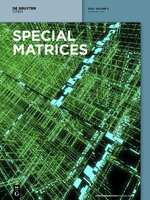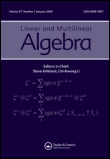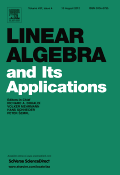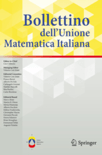
Special Matrices
Scope & Guideline
Catalyzing Dialogue in the Mathematical Community
Introduction
Aims and Scopes
- Spectral Theory of Matrices:
A primary focus of the journal is on the spectral properties of various classes of matrices, including but not limited to adjacency matrices, Laplacian matrices, and tridiagonal matrices. This includes studies on eigenvalues, eigenvectors, and their implications in different mathematical contexts. - Applications in Graph Theory:
The journal emphasizes the connection between matrices and graph theory, exploring how matrix properties can be utilized to solve graph-related problems. This includes research on spectral graph theory, where the eigenvalues of graphs provide insights into their structure and characteristics. - Matrix Algorithms and Computational Techniques:
Research that develops new algorithms for matrix computations, including efficient methods for calculating eigenvalues, determinants, and inverses, is a significant aspect of the journal's content. This includes both theoretical advancements and practical implementations. - Generalizations and Extensions of Classical Results:
The journal often features papers that generalize classical results in matrix theory, extending known theorems to broader classes of matrices or exploring new connections between different mathematical concepts. - Interdisciplinary Applications:
The journal also covers interdisciplinary applications of matrix theory, where matrices play a crucial role in fields such as statistics, physics, and engineering. This includes studies on stochastic matrices, positive semidefinite matrices, and their applications in various models.
Trending and Emerging
- Quantum Walks and Their Matrix Representations:
The publication of papers on continuous-time quantum walks indicates a rising interest in the intersection of quantum mechanics and matrix theory. This theme is relevant as it explores new mathematical frameworks that could have implications in quantum computing and information theory. - Complex and Structured Matrices:
There is an increasing focus on complex matrix structures, such as complex Hadamard matrices and their properties. This trend is important as it opens up new avenues for research in areas like signal processing and quantum information. - Eigenvalue Problems in Nonstandard Contexts:
Emerging studies are delving into eigenvalue problems within nonstandard contexts, such as in hypergraphs or signed graphs. This trend reflects a growing recognition of the importance of eigenvalues in diverse mathematical and applied fields. - Applications of Matrix Theory in Statistics and Data Analysis:
Research that applies matrix theory to statistical models and data analysis is gaining traction. This is particularly significant given the increasing importance of data science and statistics in various scientific fields.
Declining or Waning
- Classical Matrix Inequalities:
Research centered around classical inequalities in matrix theory, such as those related to determinants or eigenvalues, has seen a decrease in frequency. This suggests that the field may be moving towards more complex or generalized frameworks rather than re-examining established results. - Elementary Matrix Theory:
Papers focusing on basic properties and characteristics of matrices without substantial theoretical or application advancements are appearing less frequently. This could indicate a shift towards more sophisticated and nuanced studies that involve deeper theoretical frameworks. - Basic Combinatorial Properties of Matrices:
There seems to be a waning interest in purely combinatorial studies of matrices that do not connect to broader applications or theoretical implications. Researchers may be prioritizing studies that bridge combinatorial properties with other areas such as algebra or graph theory.
Similar Journals

ACTA SCIENTIARUM MATHEMATICARUM
Exploring Innovative Solutions in Mathematical AnalysisACTA SCIENTIARUM MATHEMATICARUM, published by SPRINGER BIRKHAUSER in Switzerland, is a distinguished journal focusing on the fields of mathematical analysis and applied mathematics. With an ISSN of 0001-6969 and an E-ISSN of 2064-8316, this journal serves as a critical platform for disseminating high-quality research that bridges theoretical and practical aspects of mathematics. Although currently categorized in the Q3 quartile for both Analysis and Applied Mathematics as of 2023, the journal strives to enhance its impact on the mathematical community by offering a perfect blend of rigorous research and innovative applications. Researchers, professionals, and students can benefit from the journal’s commitment to advancing knowledge in mathematics, despite the absence of open-access options. The mailing address for correspondences is 233 SPRING STREET, 6TH FLOOR, NEW YORK, NY 10013. As mathematics continues to evolve, ACTA SCIENTIARUM MATHEMATICARUM positions itself as a valuable resource for those looking to contribute to and stay informed about the latest developments in this vibrant field.

Acta Universitatis Sapientiae-Mathematica
Transforming mathematical challenges into scholarly opportunities.Acta Universitatis Sapientiae-Mathematica is a dynamic and open-access academic journal published by SCIENDO, dedicated to advancing research in the field of mathematics. With its roots grounded in Germany, the journal has made significant strides in promoting scholarly contributions since it became open access in 2013, enhancing accessibility for researchers, professionals, and students alike. Spanning a broad spectrum of mathematical disciplines, including general mathematics, the journal engages with contemporary challenges and offers a platform to explore innovative approaches. Although currently positioned in the Q4 quartile for 2023 within the miscellaneous mathematics category and holding a Scopus rank of #290 out of 399, the journal is committed to fostering intellectual discourse and enhancing the overall quality of mathematics research. The convergence of research presented since 2014 showcases a journey toward improvement and expanding its influence in the mathematical community. Contribute to the vibrant dialogue in mathematics by exploring the latest findings in Acta Universitatis Sapientiae-Mathematica as it continues to evolve in the academic landscape.

LINEAR & MULTILINEAR ALGEBRA
Connecting Researchers in the World of AlgebraLINEAR & MULTILINEAR ALGEBRA, published by Taylor & Francis Ltd, is a distinguished academic journal that has been contributing to the field of mathematics since 1973. With an ISSN of 0308-1087 and an E-ISSN of 1563-5139, this journal focuses on innovative research in algebra and number theory, reinforcing its standing as a vital resource for mathematicians worldwide. Currently ranked in the Q2 quartile of its category, and holding an impressive rank of 13 out of 119 in Scopus, it occupies a prominent position in the field, commanding a significant 89th percentile. The journal aims to disseminate groundbreaking research, critical reviews, and theoretical advancements, making it an essential platform for both established researchers and emerging scholars. With a publishing horizon stretching to 2024, LINEAR & MULTILINEAR ALGEBRA is poised to continually influence the mathematical community while fostering a deeper understanding of linear and multilinear frameworks.

LINEAR ALGEBRA AND ITS APPLICATIONS
Exploring Innovations in Mathematics and BeyondLINEAR ALGEBRA AND ITS APPLICATIONS, published by Elsevier Science Inc, is a prestigious journal that serves as a vital resource in the field of mathematics, specifically focusing on the areas of linear algebra and its myriad applications across various disciplines. Since its inception in 1968, this journal has established a solid reputation, achieving an impressive impact factor that places it in the Q1 category for Algebra and Number Theory as well as for Discrete Mathematics and Combinatorics in 2023, showcasing its significant contribution to these fields. The journal's rigorous peer-review process ensures that published works reflect the highest standards of scholarly research, further establishing it as a leading publication for mathematicians and researchers alike. Although it does not currently offer Open Access options, its wide-reaching audience can access invaluable findings and innovations within its pages. With a commitment to advancing knowledge and fostering innovation, LINEAR ALGEBRA AND ITS APPLICATIONS continues to be an essential platform for disseminating impactful research that shapes the future of mathematics.

COLLOQUIUM MATHEMATICUM
Pioneering research that shapes the future of mathematics.COLLOQUIUM MATHEMATICUM, published by ARS POLONA-RUCH, serves as an essential platform for the dissemination of innovative research in the field of mathematics. With an ISSN of 0010-1354 and a dedicated E-ISSN of 1730-6302, this journal plays a crucial role in advancing mathematical knowledge and fostering collaboration within the academic community. Although it is categorized in the Q3 quartile for miscellaneous mathematics, its content consistently attracts a diverse readership, reflecting a wide array of mathematical disciplines. Spanning publication years from 2001 to 2009 and resuming from 2011 to the present, *COLLOQUIUM MATHEMATICUM* offers researchers, professionals, and students the unique opportunity to engage with groundbreaking concepts and methodologies. With its home base in Warsaw, Poland, this journal not only contributes to the regional mathematical landscape but also impacts the broader global community. While currently not adopting an open access model, the journal remains committed to quality research, evidenced by its Scopus ranking within the general mathematics category. Engage with *COLLOQUIUM MATHEMATICUM* to be at the forefront of mathematical exploration.

PROBABILITY THEORY AND RELATED FIELDS
Fostering Innovation in Statistical MethodologiesPROBABILITY THEORY AND RELATED FIELDS is a premier journal published by SPRINGER HEIDELBERG, dedicated to advancing the field of probability and its applications. With an ISSN of 0178-8051 and an E-ISSN of 1432-2064, this journal has established itself as a leading platform for innovative research, featuring significant contributions to the theories and methodologies in probability, statistics, and uncertainty analysis. Its impressive ranking in the 2023 category quartiles places it in the Q1 tier within Analysis, Statistics and Probability, highlighting its importance in the academic community. The journal is widely recognized for its rigorous peer-review process, ensuring high-quality publications that cater to researchers, professionals, and students alike. Located in Germany at TIERGARTENSTRASSE 17, D-69121 HEIDELBERG, it continues to shape the future of statistical sciences from 1986 until 2024 and beyond. Researchers in the field are encouraged to contribute their findings, ensuring the journal remains at the forefront of innovative statistical research.

Algebra And Discrete Mathematics
Fostering Scholarly Discourse in Algebra and Discrete MathematicsAlgebra And Discrete Mathematics, published by LUHANSK TARAS SHEVCHENKO NATIONAL UNIVERSITY, is a pivotal academic journal dedicated to exploring the realms of algebra and discrete mathematics. Since its inception in 2012, this journal has contributed significantly to the mathematical community, catering to researchers, professionals, and students interested in advancing their understanding of both classical and contemporary mathematical theories. With categories placed in Q4 in Algebra and Number Theory and Q3 in Discrete Mathematics and Combinatorics, and rankings that place it among various domains with percentiles reflecting its niche status, the journal offers a platform for innovative and high-quality research. While the journal is currently not open access, it maintains a robust academic presence, and its continuous publication until 2024 ensures a steady stream of scholarly discourse. Researchers and academics keen on disseminating their findings or keeping abreast of the latest developments in these mathematical fields will find valuable insights and diverse methodologies within its pages.

Pure and Applied Mathematics Quarterly
Shaping the Future of Mathematics with Every IssuePure and Applied Mathematics Quarterly is a prestigious journal published by INT PRESS BOSTON, INC, focusing on the diverse and evolving field of mathematics. Since its inception in 2007, this journal has grown significantly, currently holding a Q1 ranking in the Mathematics (Miscellaneous) category for 2023, positioning it among the leading publications in the discipline. With a commitment to publishing high-quality research, Pure and Applied Mathematics Quarterly fosters innovation and dialogue within the mathematical community by providing a platform for theoretical advancements and practical applications. The journal remains accessible to researchers and professionals through its ISSN 1558-8599 and E-ISSN 1558-8602, although it does not currently offer open access. As a vital resource for mathematicians, educators, and students, this journal endeavors to expand the frontiers of mathematical knowledge and contribute to the academic dialogue surrounding this fundamental science.

BOLLETTINO DELLA UNIONE MATEMATICA ITALIANA
Fostering Collaboration in the World of Mathematical SciencesBollettino della Unione Matematica Italiana, published by Springer International Publishing AG, is a prestigious academic journal that has been a cornerstone for researchers and practitioners in the field of mathematics since its inception. With the ISSN 1972-6724 and E-ISSN 2198-2759, this journal emphasizes the dissemination of high-quality research, particularly in the miscellaneous areas of mathematics, as indicated by its ranking in the Q3 category for Mathematics (miscellaneous) as of 2023. The journal covers a wide range of mathematical disciplines, offering a platform for original research articles, reviews, and critical discussions that foster academic growth and collaboration. Established in Switzerland, the journal remains a reputable source for advancements in mathematical theory and application, appealing to a diverse audience of researchers, professionals, and students seeking to stay abreast of the latest developments in the mathematical sciences. With a converged publication period from 2008 to 2024, it continues to maintain the highest scholarly standards and serves as a vital resource for the mathematical community.

CONSTRUCTIVE APPROXIMATION
Pioneering Insights in Computational MathematicsCONSTRUCTIVE APPROXIMATION is a leading academic journal published by SPRINGER, specializing in the fields of analysis, computational mathematics, and miscellaneous mathematics. With a rich history since its inception in 1985, the journal has continued to advance the understanding and application of constructive methods in approximation theory. Representing excellence in the field, it holds a prestigious Q1 ranking across various mathematical categories, underscoring its influence and relevance, with Scopus rankings reflecting its high standing within the academic community—ranked #46 in General Mathematics and #31 in Analysis, both in the top percentiles. Although it does not currently offer Open Access options, researchers and professionals benefit from its valuable insights and innovative research contributions. As a vital platform for disseminating cutting-edge findings, CONSTRUCTIVE APPROXIMATION is an essential resource for all those dedicated to advancing mathematical sciences and applications.